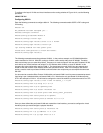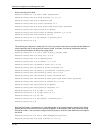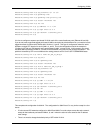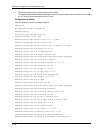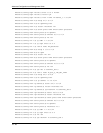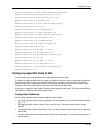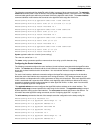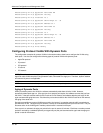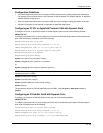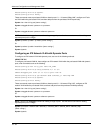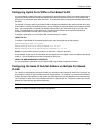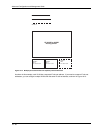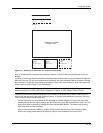
Advanced Configuration and Management Guide
• You cannot have an AppleTalk cable VLAN and an AppleTalk protocol VLAN in the same port-based VLAN. If
you already have an AppleTalk protocol VLAN in the port-based VLAN, you must delete the AppleTalk
protocol VLAN first, then configure the AppleTalk cable VLAN.
Configuration Example
Figure 3 shows an example of an HP 9308M routing switch with four AppleTalk cable VLANs configured on a
single port-based VLAN. In this example, port-based VLAN 10 is configured, then AppleTalk cable VLANs are
configured on ports on chassis modules 2 and 3. Each virtual interface (ve1, ve2, ve3, and ve4) is then
configured with AppleTalk routing information for the cable VLAN.
e3/1 e3/8...e2/1 e2/2
Port-based VLAN 10
VLAN name“cable-four”
ports 3/7 and 3/8
ve4
address 40.1
cable range 40 - 49
Zone DD
VLAN name“cable-one”
ports 2/1, 2/2, 3/1, and 3/2
ve1
address 10.1
cable range 10 - 19
Zone AA
VLAN name“cable-two”
ports 3/3 and 3/4
ve2
address 20.1
cable range 20 - 29
Zone BB
VLAN name“cable-three”
ports 3/5 and 3/6
ve3
address 30.1
cable range 30 - 39
Zone CC
HP 9308M
Routing Switch
Figure 16.13 AppleTalk Cable VLANs
Configuring the VLANs
To configure the VLANs shown in Figure 3, enter the following CLI commands:
HP9300(config)# vlan 10 by port
HP9300(config-vlan-10)# untag ethe 2/1 to 2/2 ethe 3/1 to 3/8
The two commands above add port-based VLAN 10 and add ports 2/1, 2/2, and 3/1 – 3/16 to the VLAN. The
untag command removes ports from the default VLAN and adds them to port-based VLAN 10. (The default VLAN
contains all the ports in the system by default.) The untag command also allows the ports to process packets that
do not contain 802.1p tagging.
16 - 30




